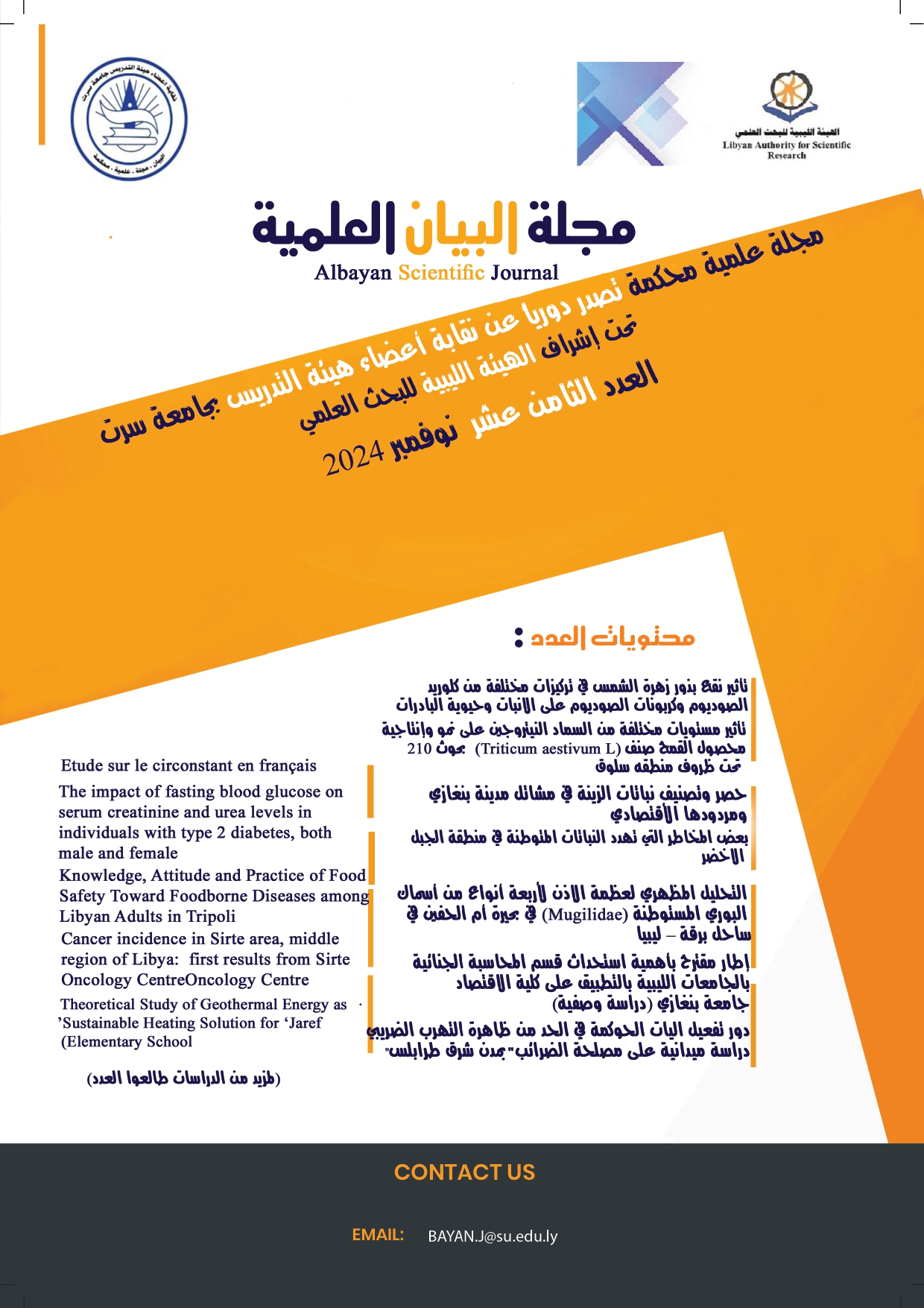Effect of irrigation levels and poultry manure on yield and quality of Barley
DOI:
https://doi.org/10.37375/bsj.vi18.3013Keywords:
Barley, irrigation rates, poultry fertilizer, crop and crop components, chemical compositionAbstract
The field experiment was conducted in the city flower nursery in the city of Tobruk during the winter season 2023-2024 to study the effect of irrigation levels and fertilization with poultry manure on the yield and quality of barley variety Giza 123. The experiment consisted of seven treatments arranged according to spilt plot design with three replicates for each treatment. The traits studied were (plant height, spike length, number of spike/m2, weight of 1000 grains (g), grain yield (tons/ha), straw yield (tons/ha), biological yield (tons/ha), harvest index (%), the chemical composition of the grains of nitrogen, phosphorus and potassium. The results showed that increasing irrigation levels up to 100% led to a significant increase in (plant height, spike length, number of spike/m2, weight of 1000 seeds, grain yield, straw yield, biological yield, harvest index), compared to irrigation level of 50% which recorded the lowest values of yield and yield components. On the other hand, the 100% irrigation rate recorded the highest grains content of nitrogen, phosphorus and potassium, compared to the 50% level which recorded the lowest values of nitrogen, phosphorus and potassium content. The results also showed that fertilization levels with poultry manure at rate of 10 tons/ha recorded the highest values of yield and yield components (plant height, spike length, number of spike/m2, weight of 1000 grains (g), grain yield (tons/ha), straw yield (tons/ha), biological yield (tons/ha), harvest index (%), compared to the control treatment that recorded the lowest values for these characteristics, The level of fertilization with poultry manure was also recorded at a rate of 10 tons/ha regarding the grain content of nitrogen, phosphorus and potassium, compared to the control treatment, which recorded the lowest values of nitrogen, phosphorus and potassium. The interaction between irrigation rates and fertilization levels with poultry manure was no-significant on yield and yield components and chemical content that were studied in this study.
References
Abbas, G., Khattak, J. Z. K., Ishaque, A. M., Hussain, M., Wahedi, H. M., Ahmed, M. S. & Ullah, A. (2012). Effect of organic manures with recommended dose of NPK on the performance of wheat (Triticum aestivum L.). J. Anim. Plant Sci., 22(3): 683-687.
Abd El-Aziz, M. A. (2013). Effect of organic amendments application on some soil characteristics and yield response of wheat and soybean. J. Soil Sci. Agric. Eng., Mansoura Univ., 4 (7): 637–645.
Abdalhi, M.A., Jia, Z., Luo, W., Ali, O.O. & Chen, C. (2020). Simulation of canopy cover, soil water content and yield using FAO-AquaCrop model under deficit irrigation strategies. Russian Agric. Sci., 46: 279–288.
Abdoun, R. M., Darwish, O. S., Hashem, F. A. & Shehata, S. A. (2023). Influence of irrigation levels on morphological attributes and yield of tomato under current and climate change conditions. J. Ecol. Eng., 24(12): 1–15.
Adeleye, E. O., Ayeni, L. S. & Ojeniyi, S. O. (2010). Effect of poultry manure on soil physicochemical properties, leaf nutrient contents and yield of yam (Dioscorea rotundata) on Alfisol in Southwestern Nigeria. J. Amer. Sci., 6(10): 871-878.
Alkhalidi, A., Assaf, M.N., Alkaylani, H., Halaweh, G. & Salcedo, F.P. (2023). Integrated innovative technique to assess and priorities risks associated with drought: Impacts, Measures/ Strategies, and Actions, Global Study. Int. J. Disaster Risk Reduct., 94: 103800.
Al-Menaie, H., Ragam1, O., Al-Shatti, A., Al-Hadidi1, M. A. & Babu, A. M. (2024). Effect of tillage and mulching on growth and yield performance of barley under different nitrogen and irrigation application rates. Ind. J. Animal Res.,1-8
Arebu, H.Y. (2022). Influence of organic fertilizers on productivity of barley: A Review. Agric. Sci. Digest., 42(2): 121-127.
Averbeke, W. V.A.N. & Marais, J.N. (1992). Maize response to plant population and soil water supply. I. Yield of grain and total above ground biomass. South Afri. J. Plant Soil, 9(4): 186-192.
Bhaskaran, U. P. & Krishna, D. (2009). Effect of organic farming on soil fertility, yield and quality of crops in the tropics. UC Davis: The proceedings of the international plant nutrition colloquium XVI. Retrieved from: http://escholarship. org/uc/item/7k12w04m.
Boantă E.A., Muntean, L., Russu, F., Ona, D., Porumb, I. & Filip, E. (2019). Barley (Hordeum vulgare L.): Medicinal and Therapeutic Uses-Review. Hop and Med. Plants, 27(1-2):87-95.
Brar, B. S., Singh, J., Singh, G. & Kaur, G. (2015). Effects of long term application of inorganic and organic fertilizers on soil organic carbon and physical properties in maize–wheat rotation. Agron., 5: 220-238.
Buckman, H.O. & Brady, N.C. (1980). The nature and properties of soil, 8th ed., eurasia publishing house (P) Ltd., New Delhi, 137-16.
Chagas, V.B., Chaffe, P.L. & Blöschl, G. (2022). Climate and land management accelerate the brazilian water cycle. Nat. Commun., 13: 5136.
Chastain, J.P., Camberato, J.J. & Albrecht, J.E. (2001). Nutrient content of livestock and poultry manure. Climate Change Central, Clemson Univ., USA. 36p.
Dadhich, S. K., Somani, L. L. & Shilpkar, D. (2011). Effect of integrated use of fertilizer P, FYM and bio-fertilizers on soil properties and productivity of soybean-wheat crop sequence. J. Adv. Dev. Res., 2 (1): 42-46.
Dehghanisanij, H., Emami, S., Achite, M., Linh, N. T. T. & Pham, Q. B. (2021). Estimating yield and water productivity of tomato using a novel hybrid approach. Water, 13(24): 3615.
Dikinya, O. & Mufwanzala, N. (2010). Chicken manure-enhanced soil fertility and productivity: Effects of application rates. J. of Soil Sci. and Environ. Manag.,1(3): 46-54.
Ding, Z., Ali, E.F., Elmahdy, A.M., Ragab, K.E., Seleiman, M.F. & Kheir, A.M. (2021). Modeling the combined impacts of deficit irrigation, rising temperature and compost application on wheat yield and water productivity. Agricultural Water Management, 244, 106626.
Dube, K., Nhamo, G. & Chikodzi, D. (2022). Climate change-induced droughts and tourism: impacts and responses of Western Cape Province, South Africa. J. Outdoor Recreat. Tour., 39: 100319.
Beadle, C.L. (1993). Growth analysis. In: Photosynthesis and production in a changing environment. A field and laboratory manual; Hall DC, Scurlock JMO, Bolhar- Nordenkampf HR, Leegod RC, Long SP (eds.). pp 36-46. Chapman & Hall, London.
Eissa, M.A., Rekaby, S.A., Hegab, S.A. & Ragheb, H.M. (2018). Effect of deficit irrigation on drip-irrigated wheat grown in semi-arid conditions of Upper Egypt. J. Plant Nutri., 41(12): 1576–1586.
Farhad, W., Saleem, M. F., Cheema, M. A. & Hammad, H. M. (2009). Effect of chicken manure levels on the productivity of spring maize (Zea mays L.). The J. Anim. Plant Sci., 19(3):122-125.
Fatemi, F., Kianersi, F., Pour-Aboughadareh, A., Poczai, P. & Jadidi, O. (2022). Overview of identified genomic regions associated with various agronomic and physiological traits in barley under abiotic Stresses. Appl. Sci., 12: 5189.
Fróna, D., Szenderák, J. & Harangi-Rákos, M. (2019). The Challenge of Feeding the World. Sustainability, 11: 5816. https://doi.org/10.3390/su11205816
Guo, R., Hao, W.P., Gong, D.Z., Zhong, X.L. & Gu, F.X. (2013). Effects of water stress on germination and growth of wheat, photosynthetic efficiency and accumulation of metabolites. In: Soriano, M. H. (ed). Soil processes and current trends in quality assessment, Chapter 13, In Tech., Rijeka, Croatia.
Hamamoto, T. (2020). Effect of organic amendment on soil carbon dynamics in agricultural ecosystems. Sapporo, Japan: Hokkaido Univ., (157 p.).
Jose, A. F. & Paterniani, R. S. (2002). Differential vegetative and reproductive performances among fifteen guinea grass hybrids. Pesq agropec bras Brasília, 37(2): 139-143.
Khapte, P. S., Kumar, P., Burman, U. & Kumar, P. (2019). Deficit irrigation in tomato: Agronomical and physio-biochemical implications. Scientia horticulturae, 248: 256–264.
Kumar, A., Singh, V., Choudhary, A. K. & Singh, A. (2022). Influence of zinc and boron application on yield, quality, and nutrient uptake of barley (Hordeum vulgare L.) under rainfed conditions. Int. J. Curr. Microb. Appli. Sci., 11 (3):1272-1279.
Kumawat, P.D. (2003). Response of Barley to Organic Manure and Nitrogen Fertilization. Ph.D. Thesis, Rajasthan Agric. Univ., Bikaner, India.
Labedzki, L. & Bak, B. (2014).Meteorological and agricultural drought indices used in drought monitoring in Poland: A review. Meteorol. Hydrol. Water Manag., 2, 3–14.
Malhi, G.S., Kaur, M. & Kaushik, P. (2021). Impact of climate change on agriculture and its mitigation strategies: A review. Sustainability, 13(3): 1318.
Maqbool, M. M., Ali, A., Haq, T., Majeed, M.N. & Lee, D.J. (2015). Response of spring wheat (Triticum aestivum L.) to induced water stress at critical growth stages. Sarhad J. Agric., 31(1): 53-58.
Martínez-Fernández, J., González-Zamora, A., Sánchez, N. & Gumuzzio, A. (2015). A soil water based index as a suitable agricultural drought indicator. J. Hydrol., 522: 265–273.
Morsy, N. M. (2019). Reducing water requirement for tomato crop in late summer through field shading. Middle East J. Agric. Res., 8(3): 808–819.
Mukherjee, A., Gaurav, A.K., Patel, A.K., Singh, S., Chouhan, G.K., Lepcha, A. & Verma, J.P. (2021). Unlocking the potential plant growth-promoting properties of chickpea (Cicer arietinum L.) seed endophytes bio‐inoculants for improving soil health and crop production. Land Degrad Dev., 32(15): 4362–4374.
Mukherjee, A., Singh, S., Gaurav, A.K., Chouhan, G.K., Jaiswal, D.K., Pereira, A.P. A., Passari, A.K., Abdel-Azeem, A.M. & Verma, J. P. (2022). Harnessing of phytomicrobiome for developing potential biostimulant consortium for enhancing the productivity of chickpea and soil health under sustainable agriculture. Sci. Total Environ., 836: 155550.
Patanè, C., Tringali, S. & Sortino, O. (2011). Effects of deficit irrigation on biomass, yield, water productivity and fruit quality of processing tomato under semi-arid Mediterranean climate conditions. Scientia Horti., 129(4): 590–596.
Pecio, A. & Wach, D. (2015). Grain yield and yield components of spring barley genotypes as the indicators of their tolerance to temporal drought stress. Polish J. Agron. 21:19-27.
Qadir, M., Sharma, B.R., Bruggeman, A., ChoukrAllah, R. & Karajeh, F. (2007). Non-conventional water resources and opportunities for water augmentation to achieve food security in water scarce countries. Agric. Water Manag., 87(1): 2–22.
Ram, M., Davari, M.R. & Sharma, S.N. (2014). Direct, residual and cumulative effects of organic manures and biofertilizers on yields, NPK uptake, grain quality and economics of wheat (Triticum aestivum L.) under organic farming of rice-wheat cropping system. J. Org. Syst., 9:16–30
Rana, B., Parihar, C.M., Nayak, H.S., Patra, K., Singh, V.K., Singh, D.K. & Jat, M.L. (2022). Water budgeting in conservation agriculture-based sub-surface drip irrigation using HYDRUS-2D in rice under annual rotation with wheat in Western Indo-Gangetic Plains. Field Crops Research, 282, 108519
Rasul, G. A. M., Ahmed, S. T. & Ahmed, M. Q. (2015). Influence of different organic fertilizers on growth and yield of wheat. Am-Euras. J. Agric. & Environ. Sci., 15 (6), 1123-1126.
Samarah, N.H. (2005). Effects of drought stress on growth and yield of barley. Agron. for Sustainable Develop. 25(1): 145-149.
Sarwar, G., Schmeisky, H., Tahir, M. A., Iftikhar, Y. & Sabah, N. U. (2010). Application of green compost for improvement in soil chemical properties and fertility status. J. Anim. & Plant Sci., 20: 258-260.
Sengar, S.S., Wade, L.J., Baghel, S.S., Singh, R.K. & Singh, G. (2000). Effect of nutrient management on rice in rain fed low land of Southeast Madhya Pradesh” Indian J. Agron., 45 (2): 315-322.
Sharma, N., Singh, R.P., Sharma, V., Singh, V. & Kumar, R. (2021). Effect of nitrogen and phosphorus management on yield, nutrient content, and uptake of barley (Hordeum vulgare, L.) in Indian semi-arid region. Ind. J. Agron., 66(1): 155-161.
Shrief, A. & Abd El-Mohsen, A. (2015). Regression models to describe the influence of different irrigation regimes on grain yield and water use efficiency in bread wheat. Adv.Agric. Biol., 4 (1): 39-49.
Singh, S.K. & Singh, K.P. (2003). Effect of long term use of fertilizers, lime and FYM on yield and nutrient uptake by wheat and soil properties. J. Res., 15: 85–87
Singh, V., Singh, S.P., Singh, S. & Shivay, Y.S. (2013) Growth, yield and nutrient uptake by wheat (Triticum aestivum) as affected by biofertilizers, FYM and nitrogen. Indian J. Agric. Sci., 83, 331–334.
Spinoni, J., Vogt, J.V., Naumann, G., Barbosa, P. & Dosio, A. (2018). Will drought events become more frequent and severe in Europe? Int. J. Climatol., 38: 1718–1736.
Srivastav, A.L., Dhyani, R., Ranjan, Madhav, M. S. & Sillanpää, M. (2021). Climate-resilient strategies for sustainable management of water resources and agriculture. Environ. Sci. Poll. Res., 28(31): 41576–41595.
Tavakoli, A.R. & Moghadam, M.M. (2012). Optimization of deficit irrigation and nitrogen rates on bread irrigated wheat at northwest of Iran. Int. J. Agri. Crop Sci., 4.
Vicente-Serrano, S.M., McVicar, T.R., Miralles, D.G., Yang, Y. & Tomas-Burguera, M. (2020). Unraveling the influence of atmospheric evaporative demand on drought and its response to climate change. WIREs Clim. Chang., 11: 632.
Wu, Y., Si, W., Yan, S., Wu, L., Zhao, W., Zhang, J. & Fan, J. (2023). Water consumption, soil nitratenitrogen residue and fruit yield of drip-irrigated greenhouse tomato under various irrigation levels and fertilization practices. Agric. Water Manag., 277: 108092.
Xiaojun, S., Wang G. & Zeleke, K. T. (2020). Crop Water Production Functions for Winter Wheat with Drip Fertigation in the North China Plain. School of Agricultural and Wine Sciences, Charles Sturt University, Wagga Wagga, NSW 2650, Australia.














